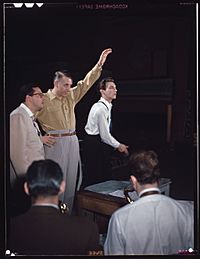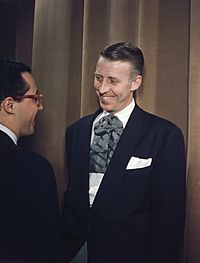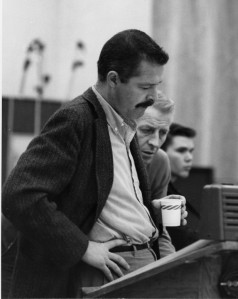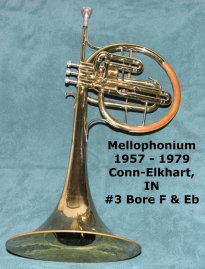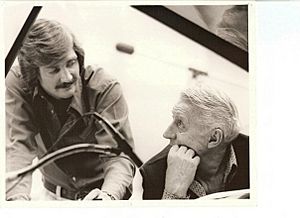Stan Kenton facts for kids
Quick facts for kids
Stan Kenton
|
|
|---|---|
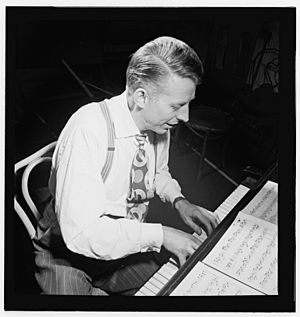
Kenton in January 1947
|
|
| Background information | |
| Birth name | Stanley Newcomb Kenton |
| Born | December 15, 1911 Wichita, Kansas, U.S. |
| Died | August 25, 1979 (aged 67) Los Angeles, California, U.S. |
| Genres |
|
| Occupation(s) |
|
| Instruments | Piano |
| Years active | 1930–1978 |
| Labels |
|
| Associated acts |
|
Stanley Newcomb Kenton (December 15, 1911 – August 25, 1979) was a famous American jazz musician. He was a talented pianist, composer, and band leader. For almost 40 years, he led an amazing and important jazz orchestra.
Kenton had many popular songs from the 1940s to the 1960s. His music was always new and exciting. He also helped start jazz education. He created the Stan Kenton Jazz Camp in 1959.
Contents
- Stan Kenton's Early Life
- Stan Kenton's Music Career
- Timeline of Stan Kenton Orchestras
- Stan Kenton's Personal Life
- Health and Passing of Stan Kenton
- Stan Kenton's Gold Records and Chart Hits
- Awards and Honors for Stan Kenton
- Stan Kenton's Music on Film and Television
- Stan Kenton's Compositions
- Images for kids
- See also
Stan Kenton's Early Life
Stan Kenton was born on December 15, 1911, in Wichita, Kansas. He had two younger sisters. His family moved to Colorado and then to Los Angeles in 1924. They settled in Bell, California.
Kenton went to Bell High School. His yearbook even called him "Old Man Jazz." He started learning piano as a teenager. When he was about 15, a pianist named Ralph Yaw showed him the music of Louis Armstrong and Earl Hines. He finished high school in 1930.
By age 16, Kenton was already playing piano regularly. He played at a local hamburger place for 50 cents a night plus tips. He also had his own group called "The Bell-Tones." His first musical arrangement was for a local eight-piece band.
Stan Kenton's Music Career
How Did Kenton Start His Career?
In the 1930s, Kenton traveled and played piano. He played with different bands, like the Francis Gilbert Territory band in 1932. He also played with the Everett Hoagland Orchestra in 1933. This was his first time playing at the Rendezvous Ballroom.
In 1936, Kenton joined Gus Arnheim's band as a pianist. He made his first recordings with Arnheim in 1937. After that, Kenton studied piano and composition more. In 1938, he joined Vido Musso's band for a short time.
Kenton also worked with the NBC House Band and in Hollywood studios. He got the idea to lead his own band while working at the Earl Carroll Theatre Restaurant. He started a rehearsal band, which became his famous group in the 1940s.
The 1940s: A Decade of Innovation
In 1940, Kenton formed his first orchestra. He was more of an arranger (someone who writes music for a band) than a featured pianist. In 1941, his band played regularly at the Rendezvous Ballroom in Newport Beach, California.
His early recordings with Decca didn't sell well. He also had a tough time as Bob Hope's backup radio band in 1943–44.
By late 1943, things changed. Kenton signed with Capitol Records. His song "Eager Beaver" became popular. The Stan Kenton Orchestra became one of the most famous bands on the West Coast. Soloists like Art Pepper and singer Anita O'Day played with the band.
By 1945, the band had grown. Pete Rugolo became the main arranger. June Christy became Kenton's new singer. Her hit songs like "Tampico" helped Kenton fund his bigger musical projects.
What Was Artistry in Rhythm?
When Pete Rugolo joined in late 1945, he brought new ideas. He loved jazz and classical music. Kenton gave him freedom to experiment. Rugolo's ideas helped the band create a unique sound.
Rugolo wrote original songs like "Artistry in Percussion" and "Safranski." These songs, along with June Christy's singing, defined the Artistry in Rhythm band. They also added Afro-Cuban rhythms. The band's sound was so big, it was called a "wall of sound."
By early 1947, the Stan Kenton Orchestra was very successful. They played in top theaters and ballrooms across America. They had many hit records. But the constant touring was very demanding. Kenton decided to break up the Artistry in Rhythm band in April 1947.
What Was Progressive Jazz?
After a five-month break, Kenton formed a new, larger band. He called their music Concerts in Progressive Jazz. Pete Rugolo wrote most of the new music. Kenton said these works were Progressive Jazz.
Bob Graettinger also wrote for the band. His important song City of Glass was first played in 1948. The band added a bongo player and a Brazilian guitarist. This allowed them to explore Afro-Latin rhythms even more.
The Progressive Jazz period lasted 14 months, from September 1947 to December 1948. The band only released one album and a few singles. This was because of a recording ban by musicians.
Many musicians from the Artistry band returned. New additions included Laurindo Almeida on classical guitar and Jack Costanzo on bongos. These were new instruments for a jazz band. The rhythm section included Eddie Safranski (bass) and Shelly Manne (drums).
The saxophone section was also improved. Art Pepper joined as the second alto saxophonist. This band was full of talented musicians. Their music was more complex than before. It was some of the first "third stream" music, which mixes jazz and classical styles.
The band toured all over the country. They played in famous concert halls like Carnegie Hall and the Hollywood Bowl. Kenton's concert at the Hollywood Bowl in 1948 drew over 15,000 people. It was a huge success.
Kenton's band broke attendance records everywhere. He was good at promoting his music. Comedy acts and June Christy's songs helped balance the serious new music.
Not everyone liked Kenton's success. Some felt his all-white band got more attention than other jazz artists. In 1948, Kenton's orchestra made over $1,000,000.
At the end of 1948, Kenton announced he would break up the band again. On December 14, 1948, the Stan Kenton Orchestra played its last show for over a year. They would return with new musicians and new music.
The 1950s: New Sounds and Challenges
After a year off, Kenton formed a huge 39-piece orchestra in 1950. It included 16 strings, woodwinds, and French horns. This group, called the Innovations in Modern Music Orchestra, toured in 1950–51. But it was not a commercial success. Kenton soon went back to a smaller 19-piece band.
In 1951, Kenton changed the band to a more standard size. It had five saxes, five trombones, five trumpets, piano, guitar, bass, and drums. Arrangers like Gerry Mulligan and Bill Holman wrote for the band. The music became more like modern be-bop big bands.
Young, talented players like Maynard Ferguson and Lee Konitz joined. The 1953 album New Concepts of Artistry in Rhythm is considered a highlight of Kenton's career. He made sure the band played both serious jazz and dance music.
When drummer Mel Lewis joined in 1954, the band became very "swinging." Albums like Contemporary Concepts (1955) and Kenton in Hi-Fi (1956) were very popular. Kenton in Hi-Fi was a re-recording of his older hits in stereo. It sold well and helped the band financially. This was important as Rock n Roll was becoming very popular.
In 1956, Kenton released the album Cuban Fire!. This album was a big success for Johnny Richards and the Kenton orchestra. It was a landmark for large Latin jazz recordings. Its success helped Johnny Richards get his own recording contract.
By the end of the 1950s, Kenton's band was facing declining sales. They had to compete with new artists like Elvis Presley. The band often played in dance halls instead of jazz concerts. In 1959, Kenton decided to change the orchestra again.
The 1960s: Mellophoniums and Grammys
In 1960, Kenton reformed his band with a new sound. He added a section of mellophoniums. This instrument helped bridge the sound between the trumpets and trombones. It added a unique color to the orchestra.
Kenton's 1961 album The Romantic Approach was the first to feature the mellophonium band. The band had many successes from 1960 to 1963. The albums Kenton's West Side Story and Adventures In Jazz both won Grammy Awards.
Ralph Carmichael wrote Christmas songs for Kenton, which became a popular album: A Merry Christmas!. After a tour in late 1963, the mellophonium band ended. Kenton took a year off to spend time with his children. He did not form another touring band until 1965.
In 1962, Kenton had his last Top-40 hit, "Mama Sang a Song." It was a spoken word song. He also tried a country music album, Stan Kenton! Tex Ritter!, but it was less successful.
After the mellophonium band, Kenton arranged Kenton / Wagner (1964). This album was more "progressive jazz." It wasn't a financial success but kept Kenton at the forefront of 'art music.' Stan Kenton Conducts the Los Angeles Neophonic Orchestra (1965) was an artistic success and got another Grammy nomination.
The late 1960s were a tough time for Kenton's recordings. His record label, Capitol Records, tried to make money from popular rock music. Kenton had little involvement in some of these albums. However, the band did have a charted single of the Dragnet theme in 1967.
The 1970s: Creative World Records
In 1970, Kenton moved from Capitol Records to Creative World Records. This was a difficult time for the music business. Kenton wanted to appeal to younger audiences. He worked with arrangers like Hank Levy and Bob Curnow.
Creative World Records released live concerts. Kenton had more control over his music. He sold records directly to jazz fans through mail. He also made his sheet music available to school bands.
Kenton continued to lead and tour with his big band. His last performance was on August 20, 1978. He stopped touring due to his health.
Timeline of Stan Kenton Orchestras

Stan Kenton's Legacy
Stan Kenton was a very important person in American music. He greatly influenced big band jazz. His music changed and grew from the 1940s to the 1970s. He also helped promote jazz education through his Stan Kenton Band Clinics. The "Kenton Style" is still taught in high school and college bands today.
Stan Kenton's Personal Life
Stan Kenton was born on December 15, 1911. For a long time, he believed his birthday was February 19, 1912. This was because his parents told him a later date to keep a family secret. His grave marker still shows the incorrect February birthdate.
Kenton was married three times and had three children. His first marriage was to Violet Rhoda Peters in 1935. They had a daughter named Leslie in 1941.
In 1955, Stan Kenton married singer Ann Richards. They had two children, Dana Lynn and Lance. They divorced in 1962, and Kenton kept custody of their children.
His third marriage was to Jo Ann Hill in 1967. They separated in 1969 and divorced in 1970. In his later years, he lived with his business manager, Audree Coke Kenton.
Health and Passing of Stan Kenton
Kenton had two serious falls. One was in the early 1970s, and another in May 1977. The second fall was very serious, and he fractured his skull. The effects of these accidents made his last two years very challenging.
On August 17, 1979, he was admitted to Midway Hospital in Los Angeles after a stroke. He passed away eight days later, on August 25, 1979. He was buried in the Westwood Village Memorial Park Cemetery in Los Angeles.
Stan Kenton's Gold Records and Chart Hits
Gold Records
- 1944 Artistry in Rhythm (instrumental)
- 1945 Tampico (vocal by June Christy and band)
- 1945 Shoo-Fly Pie and Apple Pan Dowdy (vocal by June Christy and band)
Stan Kenton's Hit Singles
(Songs that reached the top of the US or UK charts)
Between 1944 and 1967, Stan Kenton had many hit songs.
| year | Title | Chart peak position | ||||
|---|---|---|---|---|---|---|
| US | Year end position | US R&B |
US Country |
US Adult Contemporary |
||
| 1944 | Do Nothin' Till You Hear from Me (sung by Red Doris) | 20 | 8 | |||
| 1944 | Eager Beaver | 14 | ||||
| 1944 | And Her Tears Flowed Like Wine (sung by Anita O'Day) | 4 | 27 | |||
| 1944 | How Many Hearts Have You Broken (sung by Gene Howard) | 9 | ||||
| 1945 | Tampico (sung by June Christy) | 2 | 46 | |||
| 1945 | It's Been a Long, Long Time (sung by June Christy) | 6 | ||||
| 1946 | Artistry Jumps | 13 | ||||
| 1946 | Just A-Sittin' and A-Rockin' (sung by June Christy) | 16 | ||||
| 1946 | Shoo-Fly Pie and Apple Pan Dowdy (sung by June Christy) | 6 | ||||
| 1946 | It's a Pity to Say Goodnight (sung by June Christy) | 12 | ||||
| 1947 | His Feet Too Big for De Bed (sung by June Christy) | 12 | ||||
| 1947 | Across the Alley from the Alamo (sung by June Christy) | 11 | ||||
| 1948 | How High the Moon (sung by June Christy) | 27 | 27 | |||
| 1950 | Orange Colored Sky (sung by Nat King Cole) | 5 | ||||
| 1951 | September Song | 17 | ||||
| 1951 | Laura | 12 | ||||
| 1952 | Delicado | 25 | ||||
| 1960 | My Love (sung by Nat King Cole) | 47 | 12 | |||
| 1962 | Mama Sang a Song (spoken word by Stan Kenton) | 32 | 12 | |||
| 1967 | Dragnet | 40 | ||||
Stan Kenton's Charted Albums
(Albums charting history with Billboard Magazine)
| year | Album | Chart peak/ year end # |
||||
|---|---|---|---|---|---|---|
| Peak, US | Year end | |||||
| 1946 | Artistry in Rhythm | 2 (1/11/47) | #15 (1947) | |||
| 1948 | A Presentation of Progressive Jazz | *1 (5/29 – 7/17) | #1 | |||
| 1949 | Encores | 2 (2/26/49) | ||||
| 1950 | Innovations in Modern Music | 4 (4/22/50) | ||||
| 1956 | Kenton in Hi-Fi | 20 (5/5/56) | #22 | |||
| 1956 | Cuban Fire! | 17 (9/15/56) | ||||
| 1961 | West Side Story | 16 (Oct. 1961) |
||||
| 1972 | Stan Kenton Today | 146 (7/8/72) | ||||
Awards and Honors for Stan Kenton
Wins and Honors from Music Publications
| Year | Music publication |
won | honor named |
|---|---|---|---|
| 1946 | Metronome | Band of the year | |
| Down Beat | Best band of 1946 | ||
| 1947 | Metronome | Band of the year | |
| Metronome All-Stars | |||
| Down Beat | Best band of 1947 | ||
| 1948 | Metronome | Band of the year | |
| 1950 | Down Beat | Best band of 1950 | |
| 1951 | Best band of 1951 | ||
| 1952 | Best band of 1952 | ||
| 1953 | Metronome | Band of the year | |
| Down Beat | Best band of 1953 | ||
| 1954 | Metronome | Band of the year | |
| Down Beat | Best band of 1954 | ||
| Hall of Fame | |||
| 1955 | Metronome | Band of the year |
Grammy Awards
| Year | Nominee / work | Award | Result |
|---|---|---|---|
| 1962 | West Side Story (album) | Best Performance by an orchestra - for other than dancing | Nominated |
| Best Jazz Performance - Large Group (Instrumental) | Won | ||
| 1963 | Adventures In Jazz (album) | Won | |
| Best Engineered recording (other than classical and novelty) | Nominated | ||
| 1963 | Mama Sang a Song (single) | Best Documentary or Spoken Word Recording (other than comedy) | Nominated |
| 1965 | Artistry in Voices and Brass (album) | Best Performance by a Chorus | Nominated |
| 1967 | Stan Kenton Conducts the Los Angeles Neophonic Orchestra (album) | Best Instrumental Jazz Performance, Individual or Group | Nominated |
Grammy Hall of Fame
| Year | Nominee / work | Award | Result |
|---|---|---|---|
| 1943 | Artistry in Rhythm (with the Stan Kenton Orchestra) | Grammy Hall of Fame (1985) | Inducted |
International Music Awards
| Year | Award | Country | Album or single | Label |
|---|---|---|---|---|
| 1968 | Edison Award | Netherlands | The World We Know (album) | Capitol |
Other Awards and Honors
- 1978 – Honorary Doctorate of Music: University of Redlands
- 1974 – Honorary Doctorate of Humane Letters: Drury College
- 1968 – Honorary Doctorate of Music: Villanova University
- 1967 – Intercollegiate Music Festival Hall of Fame Award
- Named to the International Association for Jazz Education Hall of Fame (1980)
- Honored on the Hollywood Walk of Fame (Recording – 6340 Hollywood Blvd.)
- "City of Glass" is honored in The Wire's "100 Records That Set The World on Fire" (While No One Was Listening)".
Posthumous Honors
- 2011 – "Stan Kenton: Artistry In Rhythm- Portrait Of A Jazz Legend" (DVD)
EMPixx Awards – Platinum Award in the Documentary Category/Platinum Award in the Use of Music Category.
United States Library of Congress National Recording Registry
- Artistry in Rhythm (single) – Stan Kenton – Released:1943 – Inducted: 2011 - Category: Jazz
Stan Kenton's Music on Film and Television
- 1941 Zig Me, Baby, With a Gentle Zag (short film)
- 1942 Jammin' in the Panoram (short film)
- 1942 Jealous (short film)
- 1942 Reed Rapture (short film)
- 1944 This Love of Mine (short film)
- 1945 Eager Beaver (short film)
- 1945 I'm Homesick, That's All (short film)
- 1945 It's Been a Long Long Time (short film)
- 1945 Southern Scandal (short film)
- 1945 Tampico (short film)
- 1946 Talk About A Lady (feature film)
- 1946 Southern Scandal (short film)
- 1947 Let's Make Rhythm (short film)
- 1947 Stan Kenton and His Orchestra (biographical short film)
- 1950 The Ed Sullivan Show (television)
- 1953 Schlagerparade (movie) Stan Kenton at the Sporthalle in Berlin
- 1954 Spotlight No. 5 (CBC television, documentary)
- 1955 Music '55 (television, musical variety)
- 1956 Happy New Year: A Sunday Spectacular (television)
- 1956 Juke Box Jury (television, gameshow)
- 1957 Alan Melville Takes You from A-Z (BBC television)
- 1957 The Big Record (television)
- 1958 The Gisele MacKenzie Show (television)
- 1960 General Electric Theater (television)
- 1960 Startime (television)
- 1960 Dixieland Small-Fry (television)
- 1962 Jazz Scene USA (television)
- 1962 Music of the 60s (television)
- 1962 The Lively Ones (television)
- 1963 The Ed Sullivan Show (television)
- 1964 The Les Crane Show (television)
- 1965 Big Bands (WGN-TV television)
- 1965 Jamboree (television)
- 1966 The Linkletter Show (television)
- 1967 The Woody Woodbury Show (television)
- 1967 The Tonight Show Starring Johnny Carson (television)
- 1968 Something Special with Mel Torme (television)
- 1968 The Crusade for Jazz aka Bound To Be Heard (television documentary)
- 1969 The Substance of Jazz (educational/documentary)
- 1969 and 1970 The David Frost Show (television)
- 1968 and 1970 The Mike Douglas Show (television)
- 1971 The Merv Griffin Show (television)
- 1972 Sounds of Saturday (BBC television)
- 1976 Soundstage (television)
- 1977 Omnibus (BBC television)
- 2011 Stan Kenton: Artistry In Rhythm- Portrait Of A Jazz Legend (documentary)
Stan Kenton's Compositions
Stan Kenton wrote many songs, including:
- "Artistry in Rhythm"
- "Opus in Pastels"
- "Artistry Jumps"
- "Reed Rapture"
- "Eager Beaver"
- "Fantasy"
- "Southern Scandal"
- "Monotony"
- "Harlem Folk Dance"
- "Painted Rhythm"
- "Concerto to End All Concertos"
- "Easy Go"
- "Concerto for Doghouse"
- "Shelly Manne"
- "Balboa Bash"
- "Flamenco"
- "Sunset Tower"
Many songs were written with Pete Rugolo, such as "Artistry in Boogie" and "Collaboration." Kenton also helped write the jazz classic "And Her Tears Flowed Like Wine" in 1944.
Images for kids
See also
 In Spanish: Stan Kenton para niños
In Spanish: Stan Kenton para niños




